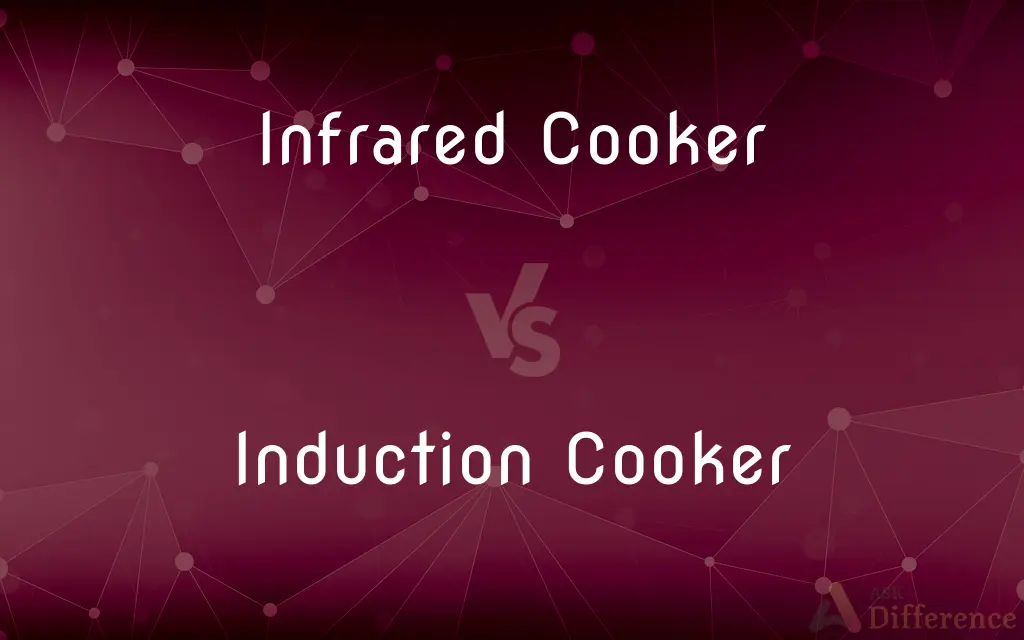Infrared Cooker vs. Induction Cooker — What's the Difference?
By Tayyaba Rehman — Published on December 14, 2023
Infrared Cooker uses infrared radiation to heat food directly, while an Induction Cooker heats cookware using magnetic fields. Both offer efficient cooking but differ in technology and application.

Difference Between Infrared Cooker and Induction Cooker
Table of Contents
ADVERTISEMENT
Key Differences
An Infrared Cooker operates by emitting infrared radiation, a type of light energy that humans can't see but can feel as heat. When this radiation strikes food or a cooking surface, it heats it up directly. The Infrared Cooker provides instant, high-heat cooking, making it suitable for grilling and searing. On the contrary, the Induction Cooker doesn't use traditional radiant heat.
Instead, an Induction Cooker employs electromagnetic fields to produce heat. When an induction-compatible pot or pan is placed on the cooker, the magnetic field induces a current in the cookware, leading to the rapid heating of the pot or pan. Unlike the Infrared Cooker, which can heat anything it touches, Induction Cookers only heat the cookware and its contents, leaving the cooker's surface relatively cool to the touch.
Both the Infrared Cooker and the Induction Cooker offer precision and efficiency in cooking. The Infrared Cooker can achieve higher temperatures quickly, which is beneficial for certain cooking techniques. On the other hand, the Induction Cooker offers safer and energy-efficient cooking, as it heats the cookware directly without wasting heat on the surrounding environment.
Selecting between an Infrared Cooker and an Induction Cooker depends on one's cooking needs. While both are efficient, the Infrared Cooker is more versatile in terms of the cookware it can use. In contrast, the Induction Cooker requires specific induction-compatible pots and pans for effective heating.
Comparison Chart
Technology
Uses infrared radiation
Uses electromagnetic fields
ADVERTISEMENT
Heating Mechanism
Directly heats food or surface
Heats cookware using induced current
Cookware Needed
Versatile with most cookware
Requires induction-compatible pots and pans
Safety
Can get very hot to touch
Surface remains cool, only heats cookware
Efficiency
Provides instant, high heat
Energy-efficient as it directly heats the cookware
Compare with Definitions
Infrared Cooker
Cookware emitting unseen light energy to heat food.
Burgers on the Infrared Cooker are always juicy and well-cooked.
Induction Cooker
A cooker that remains cool while only heating the pot.
The Induction Cooker is safer with kids around due to its cool surface.
Infrared Cooker
An efficient cooker using infrared technology for direct heating.
The Infrared Cooker made preparing dinner quicker than usual.
Induction Cooker
A cooker heating pots using electromagnetic fields.
The soup heated up quickly on the Induction Cooker.
Infrared Cooker
A modern cooking device utilizing infrared radiation.
For her backyard barbecue, Lisa preferred the Infrared Cooker.
Induction Cooker
Modern cookware using electromagnetic technology for heating.
Gourmet chefs often prefer the precision of an Induction Cooker.
Infrared Cooker
A cooker providing instant, high-heat using light energy.
She loves her Infrared Cooker for its rapid heating capability.
Induction Cooker
A device offering energy-efficient cooking using magnetism.
With her new Induction Cooker, she noticed reduced electricity bills.
Infrared Cooker
A device that uses infrared radiation for cooking.
The steak was perfectly seared using the Infrared Cooker.
Induction Cooker
Cookware that heats only induction-compatible vessels.
Mark had to buy new pots to use with his Induction Cooker.
Common Curiosities
Do I need special pots for an Induction Cooker?
Yes, you'll need induction-compatible pots and pans.
Which cooker offers quicker heating?
Both are efficient, but an Infrared Cooker provides instant, high heat.
What is an Infrared Cooker?
An Infrared Cooker uses infrared radiation to directly heat food or a cooking surface.
How does an Induction Cooker work?
It uses electromagnetic fields to induce a current in cookware, leading to heating.
Can I use any pot on an Infrared Cooker?
Yes, an Infrared Cooker is versatile and can heat most cookware.
Which cooker is more energy-efficient?
The Induction Cooker is more energy-efficient as it heats directly with minimal heat loss.
Is the Induction Cooker's surface hot to touch?
No, the surface remains relatively cool as it only heats the cookware.
How do I know if my cookware is induction-compatible?
A magnet should stick to the bottom; if it does, it's induction-compatible.
Between Infrared and Induction Cookers, which is more popular?
Popularity varies by region and preference; both have loyal user bases.
What are the safety benefits of using an Induction Cooker?
It's safer as the surface remains cool, reducing burn risks.
Can I grill on an Infrared Cooker?
Yes, it's great for grilling due to its ability to achieve high temperatures quickly.
Which is better for professional cooking?
Both have merits; the choice depends on specific cooking needs and techniques.
How do I clean an Infrared Cooker?
Wipe it down after use; some models have removable grates for easy cleaning.
Can I use an Induction Cooker as a regular stove?
Yes, it can perform most tasks that a regular stove can.
Can an Infrared Cooker work during a power outage?
Only if it's a gas-powered model; electric models need power.
Share Your Discovery

Previous Comparison
Stars vs. Planets
Next Comparison
Presale vs. General SaleAuthor Spotlight
Written by
Tayyaba RehmanTayyaba Rehman is a distinguished writer, currently serving as a primary contributor to askdifference.com. As a researcher in semantics and etymology, Tayyaba's passion for the complexity of languages and their distinctions has found a perfect home on the platform. Tayyaba delves into the intricacies of language, distinguishing between commonly confused words and phrases, thereby providing clarity for readers worldwide.












































